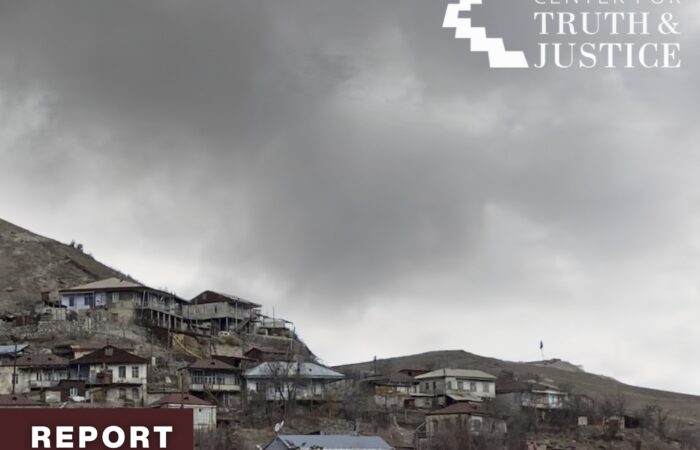Written by: Ani Tatoyan
Since the 1990s, the Republic of Azerbaijan has been deliberately engaging in the falsification of historical facts by, in particular, distorting the history of the Republic of Artsakh (also referred to as Nagorno-Karabakh).
Azerbaijan’s processes of falsifying historical facts, creating new historical realities, and presenting it the international community is carried out by both state and non-governmental organizations, such as by individuals and by the state power in the form of the presidential family and the Heydar Aliyev Foundation.[1]
The falsification of historical facts is carried out along with an anti-Armenian policy. Falsification is reflected, in particular, in Azerbaijani textbooks. The goal of such a policy is to distort historical facts and create an image of Armenians as the enemy among school-aged children.
As part of its fact-finding work, investigators of the Center for Truth and Justice collected testimonies from various people displaced from Artsakh. In their interviews, many witnesses from Artsakh expressed their fear of Azerbaijan and Azerbaijanis due to Azerbaijan’s anti-Armenian policy. One witnesses, who was a teacher and spoke Turkish, worried about the idea of living with Azerbaijanis. The witness could not imagine living with people who are taught from childhood to view Armenians in a negative light, where, in textbooks, Armenians are represented as the enemy, and, by following their news about Armenians and Armenia.
Having somewhat of an idea about the hatred of Armenians in Azerbaijan, I decided to study this issue together with the study of the distortion of historical facts. The study of the latter was due to the testimony of another witness who was a prisoner of war for almost 2 months in Azerbaijan. The witness was subjected to various types of violence, including psychological violence. During his captivity, he and other Armenian prisoners were given books titled The History of Karabakh, Azerbaijan and Yerevan Governorate. According to the witness, what was presented in the. books did not correspond to reality; it was a complete fabrication.
To understand the root of Armenian hatred in Azerbaijan, it is important to study what had occurred in the past. Azerbaijani affairs expert G. Davtyan presented the development of Armenian hatred in Azerbaijan in three stages. The first stage occurred in 1918 to 1920 during formation of Azerbaijan as a state. The second stage occurred in 1920 to 1921 during the Sovietization of Azerbaijan until Azerbaijan achieved its independence. Finally, the third stage occurred in 1991 to today due to the military operations by Azerbaijan since 1991.[2]
The following are examples of hatred towards Armenians cultivated in Azerbaijan.
5th Grade Literature Book – Brave Mubariz
“During a history lesson, a teacher was giving a lesson about the fortress of Shushi, its historical past, and impregnability. While the teacher was lecturing, Mubariz thought to himself ‘How did the Armenians capture Shushi? If we do not remove the invaders from our lands in time, we will no longer ride horses in Zydir-Duz,[3] we will not drink water from the Isa spring, we won’t swim in Dashalt[4].’ While thinking this, Mubariz’s heart filled with revenge. While growing up, the feeling of revenge in his heart continued to increase.
… The enemy violated the ceasefire every day. Mubariz could no longer tolerate the insolence of the enemy, even for one night. Taking the tricolor flag of Azerbaijan, he left the trenches. With God’s help, he moves forward. Reaching a suitable tree, he tries to rest. The sound of an Armenian soldier singing the folk song Sari gelin[5] reaches his ear. Even if he did not understand the words, he knew the song very well. He understood that the enemy was very close. He takes 10-15 steps and enters the ditch with incredible agility. He kills 5 people of the first group of the enemy he encounteres, and severely injures 3 others. He takes the weapon in his hand and leaves the trench.”[6]
In this example there is both the falsification of a historical fact and the preachment of hating Armenians. The historic city of Shushi, Artsakh is presented as an Azerbaijani propaganda of revenge. There is also ultimately the appropriation of the Armenian folk song “Mountain Girl.” This is what is being taught to 5th grade student in Azerbaijan.
5th Grade Literature Book – The Thief
“I seriously injured my leg during sports practice at school. I was forced to stay at home. All I did was watch TV. One of the TV channels was showing a program about the bad and lying Armenians. Theft is an inhumane and dishonorable act, but the theft done by Armenians is not ordinary theft, it is unique. The biggest theft has occurred to the Turks. Armenians have stolen our names, music, musical instruments, carpets, monuments, food and most importantly, our lands. They were not stolen all at once, but gradually, throughout history, in imperceptible and unusual ways. Then they shamelessly and ruthlessly do not recognize them as ours.
‘Wow, what a thieving people these Armenians have been.’ Just then, I heard a screeching sound that reminded me I was not alone in the room. It was my grandmother. She had been sitting on the couch was watching the TV program for a while. Blushing slightly, she said ‘Armenians have been stealing since ancient times, my son.’ ‘How do you know this, grandma?”I asked naively.
‘Your grandfather found out everything by asking questions. Conscientious scientists, after examining everything, found out that the cave is ancient Turkish. What the Armenian scientist wrote was nothing but nonsense. In other words, Siranuish’s brother was just as crazy as his sister.’
‘Grandma, did grandfather call our scientists from Baku?’
‘He did, my son, but the Armenians intervened and expelled us from our ancestral lands. At first we found refuge in Karabakh. Then the Armenians also took Karabakh from us. We decided to go to Baku. The name of these lands remained on your grandfather’s lips even in his last breath.’
My grandmother was deeply moved.
‘You know, my son, Turks have had everything since ancient times, they have lived a full life. Unlike the Armenians we have not touched nobody’s feelings. Maybe that’s why they often don’t know the value of their property…’”[7]
In this story, the character of the thief is presented through Armenians. In other words, if someone is a thief, they are an Armenian by principle. In addition, not only is it presented that Artsakh is a territory of Azerbaijan, but historical territories of Armenia are as well.
5th Grade Literature Book – Bloody Violet
“‘Dad, what is an enemy?’ The father was a little confused. He did not know how to answer the girl.
‘My daughter, who did you hear that word from?’
‘From Susan, she said we are enemies.’
‘My daughter, they are the enemy.’
‘And who are the Turks?’
‘We are Turks, my daughter.’
‘But aren’t we Azerbaijanis?’
‘No, my daughter, Azerbaijan is the name of our land. To separate us from the Turkish world, they took away our religion, our alphabet. You will know all this when you grow up.’”[8]
This story presents the relationship of an Azerbaijani girl with an Armenian girls and how the Armenian girl hates her. It also presents that the Armenians seized Azerbaijan’s religion and alphabet. How can a Christian country with its own alphabet conquer Islam and the Turkic alphabet?
In biology textbooks, where the characteristics of the musculoskeletal system, respiratory system and other systems are presented, Armenians are and Armenia are used as an example. For example, in one textbook it states “During the expulsion of Azerbaijanis from Zangezur, the condition of every second person worsened and the was a need for artificial respiration. Some did not reach their destination, some remained alive. Explain the reason for what happened to the people.”[9]
According to the physiologist A. Sargsyan’s studies, in Azerbaijan, it is not only the textbooks that serve to demonize the image of Armenians and to instill Armenian hatred. Various methodical manuals, extracurricular reading materials, etc. also serve the latter. For example, E. Zeynalli’s short story The Armenian, an extracurricular reading in secondary schools in Azerbaijan, includes the following statements: “Armenians are vile, and they should all be destroyed,” “Armenians should be wiped off the face of the earth,” “Armenians are ‘dogs,’ ‘cruel,’ ‘with dirty blood’” and so on.[10]
In Azerbaijani textbooks, the policy of retelling Armenian history as Azerbaijani is also being developed. For example, Sanatruk, an Armenian king in the 1st century, is mentioned in an Azerbaijan 7-th grade book titled History of the Middle of Ages. In the book, there is the question “Who was Sanatruk and what did he fight for?”[11] The correct answer to this question is “Sanatruk was the leader of the Paytakaran province, who fought against the spread of Christianity and tried to preserve the territorial integrity and sovereignty of Albania.”[12] The Albanization of the 11th of the 15 provinces of Great Armenia, and the first king Arshakuni dynasty, Sanatruk, is a distortion of history.
There are many other examples of the spread of anti-Armenian propaganda through the falsification of history. One vivid example of the hatred of Armenians is the famous “Trophy Park,” which has been visited by hundreds of Azerbaijanis.[13]
During the 44-day war, the whole world was silent, believing that Azerbaijan was reclaiming its lands, but until now no one has spoken about the occupation of Shushi and other territories of Artsakh, the terrible violations of human rights, the use of illegal weapons, and many other war crimes. If the only issue for Azerbaijan was Artsakh, then why is an Armenian prisoner given a book where it is mentioned that Yerevan, the capital of Armenia, is Azerbaijani? Why is Lake Sevan, which is in the territory of Armenia, presented as Azerbaijani on an Azerbaijani wine bottle?
In conclusion, what happened in September 2020 was the result of racism, the result of the falsification of history, and anti-Armenian propaganda in school textbooks for the past 30 years. The genocidal policy initiated by Azerbaijan and the crimes against humanity mentioned above can become a basis for the extermination of an entire nation.
[1] Մինասյան Է., ԼՂՀ պատմության նենգափոխումը Ադրբեջանական դասագրքերում | «ԼՂՀ դատական իշխանություն», թիվ 2 (6), Երևան, 2012, էջ 5-15.
[2] Դավթյան Գ., Հայատացությունը Ադրբեջանի պետական գաղափարախոսության հիմքում, Երևան, 2019, էջ 24-43.
[3] Referred as Hunot Gorge by Armenians. Hunot Gorge is a natural reserve located in Shushi.
[4] Referred as Karintak river by Armenians. On the left bank of it is a village of the same name.
[5] In Armenian, the song is referred to as “Mountain Girl.”
[6] Հայատացության քարոզչությունը Ադրբեջանում՝ դպրոցահասակ երեխաների շրջանում։ «Ժողովրդավարական համախմբում» կուսակցության կենտրոնական գրասենյակ, Եր․, 2021, էջ 10-14.
[7] Id., pages 15-25.
[8] Id., pages 26-38։
[9] Մեդիան և տեղեկատվությունը XXI դարի պատերազմներում։ Գիտաժողովի նյութեր։ Սարգսյան Ա․, «Ռազմավարի պուրակը» որպես Ադրբեջանի հայատյաց պետական քաղաքականության տրամաբնական շարունակություն, Եր․, «Ակտուալ արվեստ», «Բանք», 2021, էջ 26.
[10] Id., pages 27-28։
[11] См., Адибекян А., Элибегова А., Арменофобия в Азербайджане, Ереван, 2013, с 190-191.
[12] Id.
[13] Neil Hauer, Azerbaijan’s ‘Ethnic Hatred’ Theme Park Draws Ire, Imperils Reconciliation, Radio Free Europe / Radio Liberty (22 April 2021, 9:05 p.m.), https://www.rferl.org/a/azerbaijan-karabakh-theme-park-armenia-ethnic-hatred-aliyev/31217971.html.


